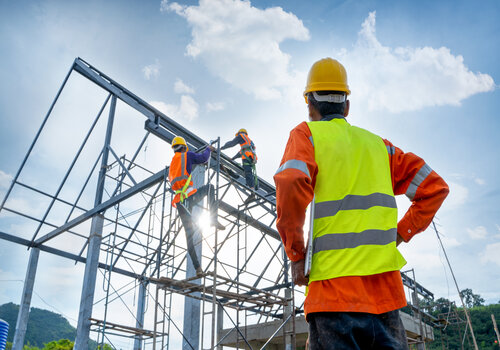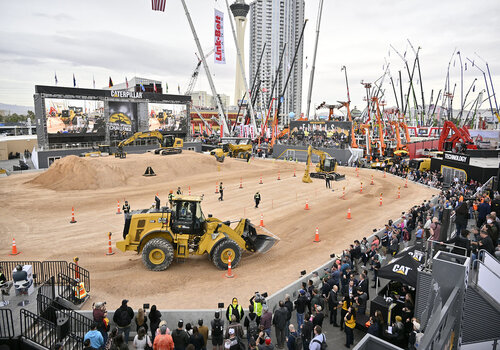3D printing has been used to print houses, offices and other structures, but what about bridges and roads?
3D printing, also known as additive manufacturing, involves laying down cross-sectional layers of material until a complete object is built. Construction 3D printing typically starts with a digital model, which is then virtually sliced into layers. Using materials such as metal, concrete or polymers, a printing robot follows a preprogrammed path to deposit each layer, tracing the layer and placing the material.
Once one layer is complete, it begins the next on top of the first, continuing until the full structure is built. This technique allows for the construction of complex structures with precision and speed, and with less material waste.
Now, the game is on to leverage 3D printing for bridges and roads.
To date, there have been multiple pedestrian and biking bridges that have been 3D printed – mainly in Europe and China, says Ali Kazemian, assistant professor in the Bert S. Turner Department of Construction Management at Louisiana State University in Baton Rouge.
“I think there is a lot of potential for segmental bridges, as these segments can be fabricated by construction printers either in a prefabrication factory or on the bridge construction sites,” Kazemian says. “More research and experimentation are definitely needed, but early data and demonstration projects show us the possibility of building cheaper and faster with this new robotic construction technology.”
As the field of 3D-printed bridge construction advances, it opens up broader possibilities for designing and constructing optimized bridge structures, he says. Topology-optimized designs can reduce the material consumption and weight of bridge elements. In turn, the reduced weight of bridge elements can reduce the costs associated with the transportation and assembly of these elements.
In addition to the prefabrication scenario, construction 3D printing can also be used for onsite fabrication of bridge elements.
“Robots can be deployed from a temporary onsite factory at the bridge construction site to fabricate bridge elements as needed, eliminating the significant costs associated with the transportation of massive concrete elements from a factory to the site,” Kazemian says. “Such an onsite bridge construction approach will also provide more flexibility in terms of necessary modifications needed to address possible errors or unexpected changes during the construction and bridge erection process.”
There are a few main challenges in the field of construction 3D printing, including 3D printed bridge construction, which need to be addressed, he says. One is concrete reinforcement.
“Manual rebar installation, which is used in traditional concrete construction, is not the most efficient reinforcement approach,” Kazemian says. “We need automated, integrated and effective reinforcement techniques which work seamlessly with robotic construction 3D printing, while satisfying the structural design requirements.”
Another challenge in construction 3D printing is the process variations and quality control issues which affect the reliability and robustness of this construction method, he says. The dimensional accuracy of 3D printed bridge elements needs to be high to ensure a seamless bridge erection process. Layer deformations and extrusion variations in concrete 3D printing can reduce the shape fidelity of printed bridge elements and deviations from design CAD models.
Kazemian’s research team at LSU, supported by the National Science Foundation, NASA and US Department of Transportation, has been researching innovative techniques to improve the reliability and robustness of construction 3D printing process.
“We have been able to implement and study innovative reality capture technologies based on computer vision, structured laser light and LiDAR sensors to improve the automation level and reliability of this bridge construction method,” Kazemian says. “In addition, we have successfully designed and tested a dual automated reinforcement technique which can be used in some applications to efficiently print bridge segments.”
The LSU team’s research findings also apply to other applications of construction 3D printing, such as low-income housing, disaster relief and extraterrestrial construction, he says.
A lot of people have an interest, but currently there are very limited applications in 3D printing for road repair, maintenance and construction.
Zhanping You
Professor, Department of Civil, Environmental and Geospatial Engineering, Michigan Technological University
For road construction, 3D printing is a very innovative technique and it has attracted a lot of attention, says Zhanping You, a distinguished professor in the Department of Civil, Environmental and Geospatial Engineering at Michigan Technological University in Houghton.
“With 3D printing, we can use recycled materials in the construction, which can potentially reduce a lot of waste,” You says. “It can also improve environmental sustainability by reducing CO2 emissions when constructing or maintaining roads.”
You and his research team at MTU design a lot of specialized materials with recycled materials. For example, they are doing research work with recycled tire rubber, plastic and glass, potentially using these to make new materials to build roads or other civil engineering structures.
Another benefit to using 3D printing in road construction is that the process fits in well with the way contractors place material on the road layer by layer, he says. After one layer is done, they do the compaction, make sure the density and thickness are good enough, and then they place the second layer and then go to the third layer, continuing to the top.
“Likewise, 3D printing also has a layer-by-layer procedure, so it can be advantageous when doing layer-by-layer road construction,” You says. “Moreover, the geometry of a road is typically not very complicated, and long rectangular stretches may be easy to do with 3D printing.”
Using 3D printing can also be very efficient. Contractors can finish the project faster, as well as use less resources and less laborers, he says. Moreover, with more innovative materials and good designs, roads can be more durable and last longer.
“A lot of people have an interest, but currently there are very limited applications in 3D printing for road repair, maintenance and construction,” You says.
For asphalt roads, usually the current practice is to use pretty hot materials like hot asphalt blended with hot stones, at about 300°F or higher temperatures. If 3D printing were to be used, the printer should be large enough to maintain the temperatures, so the materials won’t get cold and stuck during the printing.
“That is maybe the biggest hurdle currently in my opinion,” he says.
However, road construction can be done with 3D printing when the regular ambient temperature is around 50° to 90°F.
“We can start the 3D printing work since the materials can flow and can be compacted in such ambient temperature, so we don't need to raise the temperature very high,” You says. “This might be a potential strategy for adopting 3D printing in asphalt pavement construction.”
For concrete pavements, the materials usually need some time to cure to gain strength, he says. While new materials that can cure faster can be designed, still the longer time to cure the concrete in general means that 3D printing may not be very readily adopted in those situations.
To fix a pothole, a smaller 3D printer could make the job more feasible to do with this technology, You says. But for new construction of roads, a 3D printer would have to be big enough to print the size of the layers needed for each lane.
Will the use of 3D printing in road construction become more popular down the road?
“I think so,” he says. “As people get more and more concerned about emissions and energy consumption, using 3D printing to build roads more efficiently with less emissions is very likely to happen.”
Join tens of thousands of construction industry leaders and get great content delivered straight to your inbox each week with the CONEXPO-CON/AGG 365 newsletter. Subscribe today!
Photo credit: YA_CREATE/BIGSTOCKPHOTO.COM












